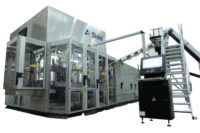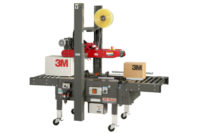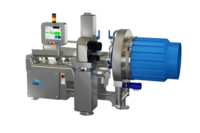Flexible Packaging recently caught up with Uli Jorgens, sales and technical director, slitter/rewinder division, Karlville, for an overview of all-things slitting/rewinding.
What’s new in the world of slitting/rewinding?
Jorgens: For us, it is important to continuously enhance key sections of our slitter/rewinders, like slitting concepts, differential rewind systems and tension control, to improve finished roll quality and simultaneously improve productivity. For example, our floating lay-on rollers to control finished roll density work well. However, for higher speeds and larger rewind roll diameters, we offer pendulum or linear lay-on roller concepts. Customers have been pleased with this alternative concept. We made advancements in finished roll handling to reduce operator-influenced down times. Furthermore, recipe storage, automatic knife positioning and core loading ensure to produce the same roll quality over and over again with different operators. It is an enormous help obtaining consistent rewind roll quality.
We’ve been hearing a lot about automation and Industry 4.0 lately. How has (or hasn’t) slitting/rewinding technology fit in with these concepts?
Jorgens: The path to industry 4.0 from a slitting/rewinding perspective continues to be evaluated. For example, the ability of the machine operator or converting supervisor to access remotely the machine’s HMI via their PC or mobile device to check on a current job. The aim is to expand on the scope of available data and commands available with this feature. Although unrelated to Industry 4.0, advancements in machine design to increase automation on the production floor are already providing dividends to converters.
What are some of the biggest factors that are impacting slitting/rewinding equipment development?
Jorgens: We are seeing that ease of use and reliability continue to rank high in this category as well as price, safety and finished roll quality. Ergonomics are an important part of efficiency, safety and overall appearance. More and more slitter/rewinder manufacturers pay attention to this fact and incorporate ergonomics at the design stage. Ease of operation, clean design and appearance make the operator proud to work on such a machine, and the operator proudly takes ownership of the equipment. The desired result in efficiency is quite remarkable.
The HMI screens must be intuitive to help new operators learn how to run the machine in a shorter timeframe. The changeover from razor slitting to shear slitting should be fairly easy and quick. The careful sourcing of key components of the machine such as drives and motors from reputable, proven suppliers are important and always a big part of our customer consultations. Since high-quality components impact machine costs, we have mitigated their effect through batch production of machines. This allows for economies of scale and volume discounts from component suppliers that benefit end users. For example, Karlville ranks amongst the highest volume slitter manufacturers in the world via our partner WebControl, where our Classic slitter carries the best-seller status.
As the last value-added step in roll production, what are the benefits of a well-working slitter/rewinder? What about the consequences of one that’s not working as it should?
Jorgens: The leading benefits of a reliable slitter/rewinder machine are good cutting accuracy and maintaining proper tension control to produce quality finished rolls (i.e., taper control). The absence of this carries serious consequences, ranging from loss of time to bottlenecks, that can ultimately affect a converter’s delivery commitments to end customers. We all can agree that reduced downtime increases efficiency. A slitter/rewinder is the final equipment in the production process of flexible packaging material and the last chance for a quality check.
The manual setup time of slitting knives is time consuming, error prone and unsafe. Selecting semi-(bottom knives only) or fully automatic knife positioning is safe, precise and reduces setup time significantly. Another improvement is to reduce the operator-influenced time of rewind roll change. There are quite a number of solutions offered, like turret rewinders, rewind roll push-off and unloading systems, auto finished roll labeling and packing concepts.
Can you explain the difference between a slitter and a slitting inspection machine?
Jorgens: The most efficient way to inspect a printed roll would be before laminating using a dedicated inspection machine. The main difference between the two machines is that an inspection machine offers bi-directional roll travel to change the print direction of a roll or to employ a 100 percent print inspection system whereas a slitter machine does not. Additionally, any slitting that is done on inspection machines is for the purpose of trim removal employing two razorblade holders whereas slitter machines employ multiple razorblade holders to convert a master roll into narrower rolls. Bottom line: We recommend the removal of defective material at a dedicated doctoring machine before laminating and slitting. This quality assurance approach will increase customer awareness of optimum production process.
Is there anything else you’d care to share about slitting/rewinding?
Jorgens: At times, we have seen how the slitter/rewinder machine can be an overlooked item either in a plant reorganization or expansion, leaving the buyer to work with a smaller than ideal budget and/or to place more emphasis on delivery time in his supplier decision. Therefore, we wish to stress the importance of exploring slitting equipment needs at an early stage where the incumbent supplier or an alternative supplier can provide the buyer with the opportunity to view extra machine features in the field that may not get their deserved attention when time is short. Lastly, it is important to note that material quality and operator skill level play a strong part in a slitter machine’s performance.





